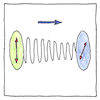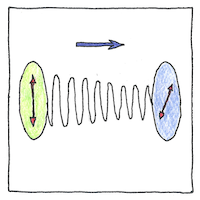Michael Faraday,
John Kerr,
Aimé Cotton,
Woldemar Voigt,
Pieter Zeeman,
Henri Mouton,
Johannes Stark,
Antonino Lo Surdo
electromagnetism

|
Magneto-optic and electro-optic effects
Magneto-optic and electro-optic effects named after the scientists who discovered them: the Faraday effect, 1845 the electro-optic Kerr effect, 1875 the magneto-optic Kerr effect, 1877 the Cotton effect, 1895 the Voigt effect, 1898 the Zeeman effect, 1902 the Cotton-Mouton effect, 1907 and the Stark-Lo Surdo effect, 1913. A magnetic force rotates a polarized light. A translucent material exhibits birefringence under an electric field. A magnetized surface rotates the light reflected from it. Proximity to the absorption band of a material affects optical rotation. A gas exhibits birefringence in a transverse magnetic field. A magnetic field splits a spectral line into multiple parts. A liquid exhibits birefringence in a transverse magnetic field. An electric field splits a spectral line into multiple parts.
Faraday effect
Light and electromagnetism are related, which Michael Faraday was the first to show by shining a polarized light through lead glass and applying a magnetic force in the direction of the light so that the polarization rotated in proportion to the strength of magnetic force.
Electro-optic Kerr effect
Apply a voltage to a translucent material. A light shining through it shows birefringence, where the light oscillating in the direction of the electric field and the light ocsillating across the electric field are refracted at different angles.
Magneto-optic Kerr effect
Light reflected from a magnetized surface is rotated and reflected with different intensities according to the direction of magnetization so the crystallization of a metallic surface can be made visible using a polarized light.
Cotton effect
The plane of polarization of light shining through an optically active liquid rotates in one direction at higher frequencies close to the absorption band of the liquid and in the opposite direction at lower frequencies.
Voigt effect
An optically active gas exhibits a double refraction of light proportional to the square of a transverse magnetic field. You may investigate further for how to calculate eigenvalues and eigenvectors from dielectric cubic tensors.
Zeeman effect
A magnetic field splits spectral lines into multiple parts and their distance depends on the strength of the field, which lets us map magnetic fields of stars and gives birds their magnetic compass.
Cotton-Mouton effect
A liquid exhibits birefringence in a transverse magnetic field. It’s like the Voigt effect but with a liquid instead of a gas. It’s like the Kerr effect but with an magnetic field instead of an electric field.
Stark-Lo Surdo effect
The Stark-Lo Surdo effect is like the Zeeman effect but spectral lines split in an electric field.
Thus
Faraday felt sure light and electromagnetic forces had something in common. Thus the magneto optical drive that can write data using a magnetic field and read it using polarized light. Thus high-speed photography using a Kerr cell to modulate light by changing an electric field. Thus the Kerr microscope that visualizes magnetic domains of a metal surface. Thus ellipsometry for visualizing dielectric properties of thin films. Thus polarimetry for remote sensing from outer space. Thus atomic line filters for lidar mapping through clouds and jungles. Thus using a Zeeman slower for laser cooling. Thus electroabsorption/emission spectroscopy for analyzing physiochemical properties of a sample.
Limited senses
Dung beetles roll their dung balls in straight lines guided by the polarization of the sky, which they see. Polarized sunglasses can show us the same information though we don’t need to roll dung balls in straight lines.



Faraday proposed in 1847 that light was a high-frequency electromagnetic vibration.
Just a word about polarization of light. Light is a wave, but the waving has two arms perpendicular to each other and perpendicular to the direction of propagation. A polarized light eliminates one of these arms, so that the light waves in only one direction.
See also in The book of science:
Readings in wikipedia: